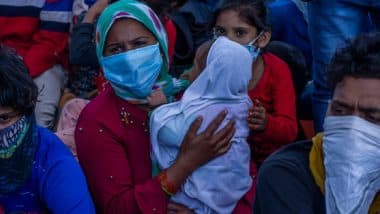India, the world’s second-most populous country, is grappling with coronavirus outbreak with the total number of positive cases crossing 2500-mark on April 3. The country is currently under a lockdown phase, which is aimed to contain the spread of the deadly virus. So far, India has reported 62 deaths due to COVID-19 with as many as 2322 active cases as on April 3. Fear and panic gripped people of India, with only one thought in mind-- has India entered the third phase of coronavirus spread? Or has community transmission of COVID-19 begun? Several health experts fear that the count will see a sudden spike in the coming days as COVID-19 positive cases are on a rise, prompting the medical staff to gear up for the avalanche of coronavirus. When Will Coronavirus End in India? This Graph Shows Importance of Lockdown and Forecast With Dates When India Can Get COVID-19 Free.
At present, India is in ‘Stage 2’ of transmission of the pandemic- i.e. local transmission stage. In March, the Health Ministry confirmed that India has not slipped into the third stage of the global pandemic. The COVID-19 cases recorded so far are either of those who returned from abroad or came in contact of people with travel history to affected nations. However, the outbreak of COVID-19 in India may transcend to 'Stage 3' if victims share no recent travel history nor came into contact with foreign returnees. On March 2, the Health Ministry identified 20 existing and 22 potential hotspots in India and asserted that there is no evidence of widespread community transmission of COVID-19 in the country so far.
The government continues to maintain its stand that India has not entered the community transmission stage yet. However, doubt has been cast over the claims after the country reported its biggest daily rise in number of COVID-19 cases following a congregation in Delhi's Nizamuddin. The government’s decision to impose the lockdown in India was a much needed one in the country’s decisive battle against the COVID-19 pandemic.
Stages of Coronavirus Spread:
The world has been hit by a deadly viral outbreak known as COVID-19 or coronavirus. There are four stages of the spread of COVID-19 pandemic.
First Stage:
In the first stage of the spread, COVID-19 positive cases are reported from people having travel history to countries that are affected by the disease. In this stage, the disease doesn’t spread locally. The situation is under control in the first phase.
Second Stage:
In the second stage, local transmission takes place and fewer people are affected and the source of virus is known. Local transmission happens when people, who travelled to affected countries, get infected by the virus and transmit it to people they come in contact with. This means infected people spread the virus wherever they go and infect others- usually close ones including friends and family. In the second stage, tracing the infected people becomes easy and convenient following which, people can be quarantined.
Third Stage:
In the third stage, the source of the infection is untraceable. The infection spreads on a higher rate and clusters of cases are reported. In this stage, the spread of the disease becomes difficult to control. At the third stage of transmission, people who are infected by the virus are the ones who have no travel history to affected nations but are still tested positive for COVID-19.
Fourth Stage:
This is the worst stage of the spread of the virus. In this stage, the transmission is uncontrollable and major clusters of infections are reported from all over the country. The disease becomes an epidemic and number of infected persons increases exponentially. Is Coronavirus an Epidemic or a Pandemic? Know The Meaning and Difference Between These Terms.
The World Health Organisation (WHO), in its release, has chalked out four levels of COVID-19 transmission. These are countries or local areas with- 1. No cases reported. 2. Sporadic cases. 3. Clusters of cases (grouped in place and time), or 4. Community transmission.
In India, the total number of confirmed cases of novel coronavirus in India stood at 2,547, according to the Ministry of Health and Family Welfare on April 3. Of the total cases, 2,322 are active cases of COVID-19, 162 individuals have recovered and discharged from the hospital, one person migrated to another country and 62 people have succumbed to the disease.
Cluster Containment Action Plan Activated in Maharashtra
Among the affected states, Maharashtra is the worst-hit with 490 COVID-19 positive cases in the state. In the highest single day toll so far, Maharashtra recorded six deaths due to coronavirus on April 3 and the number of positive cases shot up by 67 from 423 to 490. Mumbai notched the highest number of positive cases - 43, followed by 10 in the Thane region, nine in Pune, three in Ahmednagar, and one each in Washim and Ratnagiri.
In the wake of the rising number of coronavirus cases in Maharashtra, the state government has rolled out a 'Cluster Containment Action Plan' in zones where COVID-19 positive patients have been found. The teams conduct door-to-door surveys in a 3-km radius from where 3 or more coronavirus patients have been found. The teams are basically involved in contact tracing, surveys and raising awareness. Coronavirus Age-Wise Mortality Rate: Why Patients Below 40 Years of Age Should Worry Less About COVID-19 Outbreak.
Take a Look at the Tweet:
🚨“Cluster Containment Action Plan”
has been activated in zones where Corona +ve patients have been found
Here are some details: pic.twitter.com/2iqUL6aSef
— CMO Maharashtra (@CMOMaharashtra) April 3, 2020
Social Distancing- An Effective Tool To Prevent COVID-19 Transmission
At the time when COVID-19 cases are on a rise, experts believe that social distancing and isolation is an important intervention to contain local and community transmission of the coronavirus outbreak. In India, the spike in the count has doubled in the last one week. The government informed that the coronavirus outbreak in India is, technically, still in local transmission stage, and there has been no community transmission so far. Is Coronavirus Airborne?
On March 31, Joint Secretary Health Lav Aggarwal compared the ratio of coronavirus cases with other affected nations and said that during lockdown period in India, the viral infection took 12 days to reach from 100 cases to 1,000 cases. In western countries, 3,000 -5,000 cases have been found in the same time period. On March 22, the viral infection had spread into 75 districts in 23 states and Union Territories and within six days, the infection spread into 160 districts across 27 states.
(The above story first appeared on LatestLY on Apr 04, 2020 09:26 AM IST. For more news and updates on politics, world, sports, entertainment and lifestyle, log on to our website latestly.com).













 Quickly
Quickly











